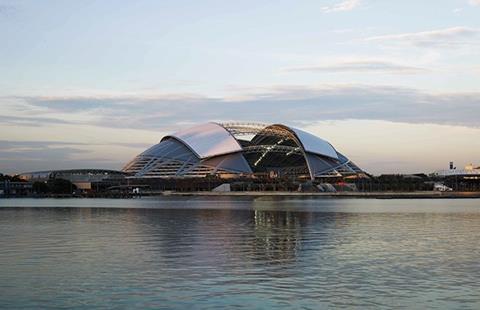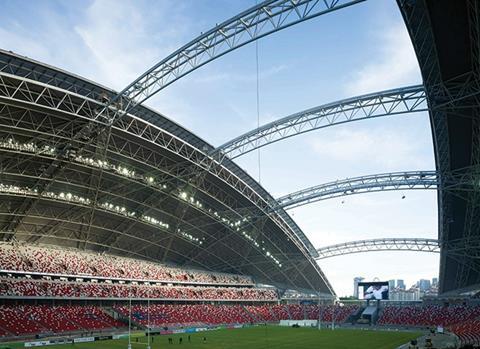It isn’t so much the Singapore National Stadium’s vast steel dome that sets it apart, as the pioneering cooling system that might just come to the rescue of the 2022 Qatar World Cup

With the new Premier League season now in full flow, sports stadiums are once again very much in the public eye. But internationally celebrated as English club football may be, it has no stadium to compare to Singapore’s newest sporting hub.
The Singapore National Stadium forms the centrepiece of a £600m 35ha leisure development on an impressive waterfront site close to the city-state’s famous Marina Bay. The development masterplan has been designed by Arup, Aecom and local practice DP Architects and includes several other sporting, recreational, leisure and retail amenities. These have incorporated celebrated Japanese architect Kenzō Tange’s tent-like 1989 Singapore Indoor Stadium on the same site.
But in every way, the new stadium is the physical and symbolic heart of the development. The 55,000-seater stadium has been designed as a collaboration between Arup, which acted as engineers, and Arup Associates, the architects.
The multi-purpose stadium claims to be the first in the world with an integrated, purpose-built design for football, rugby, athletic and cricket events. It is also the largest sports infrastructure project in the world to be delivered by PPP (public private partnership), a relatively rare procurement route in Singapore.
The stadium’s defining feature is its vast 75,500m² steel dome, the largest free-span dome in the world. With a span of 310m, it is almost 10 times the diameter of the dome of St Paul’s Cathedral, and with an internal height of 83m, it is taller than the Sydney Opera House and over 50% taller than London’s Millennium Dome, now called the O2.
But it is not just the unprecedented size of the dome that is remarkable. Almost a third of the roof dome is fully retractable providing daylight, shade and cooling when closed in Singapore’s hot and humid climate.
Crucially, this moving roof is also linked to the stadium’s pioneering ventilation strategy which, rather than mechanically cooling the entire volume in the conventional Singaporean manner, employs an innovative “localised blanket” cooling system that utilises natural airflow within the stadium and concentrates cooling in the areas where it is required most.

In doing so the Singapore National Stadium is able to use just one-sixth of the energy that would be required for a conventional stadium of a similar size. It also sets a useful precedent for large stadiums in other tropical countries, most notably Qatar whose controversial hosting of the 2022 World Cup may well be defined by the effectiveness (or otherwise) of the cooling strategies devised for its prospective venues.
According to Arup project lead Clive Lewis, the design for the masterplan was partially inspired by the inter-connected canopies of the Munich 1976 Olympics. He describes the dome itself as a “response to the climate based on the concept of a super-lightweight protective umbrella”.
Structurally the dome comprises four main elements: an elliptical skeletal truss superstructure frame, fixed metal shell cladding, a retractable ETFE roof section and giant louvres that enclose a planted public boulevard integrated into the dome’s perimeter.
With a combined steel weight of just 8,000 tonnes or 120kg/m², the roof of the Singapore National Stadium is one of the lightest of its kind in the world and is around a third lighter than comparable stadiums around the globe.
Lewis attributes this structural efficiency to local climate and the ability to refine the parametric design by using state-of-the-art software modelling. “With Singapore’s climate we didn’t have to accommodate wind loading, seismic loading or snow loading,” he says.
“By developing and analysing the truss frame by constant software modelling, we were also able to develop an efficient structure that is reminiscent of the Lotus flower that has strong local symbolic and cultural significance.”
The cladding overlaid above the structural truss frame is composed of fixed, highly reflective aluminium panels that provide both thermal and acoustic insulation. It is a fully unitised system that almost acts like a rainscreen. Rather than a conventional trapezoidal deck, the composite panels comprise purlins and micro-rib soffits which means that they weigh a relatively low 30kg/m². This represents a 15% saving on the design target. Extensive testing was also carried out on full-scale mock-ups of the cladding panels.

Lewis compares the retractable ETFE section of the dome to “a handkerchief over a fixed roof”. This complex 20,000m² section of the dome, which can fully open or close in just 20 minutes, had to satisfy a number of structural and visual requirements. It needed to be lightweight, admit daylight, provide solar shade, accommodate rotational structural movement, conform to the geometry of the fixed roof below and provide nocturnal illumination.
The use of ETFE was seen as the most practical and innovative way of meeting these demands. The ETFE pillows sit within a secondary lightweight steel frame that sits on pin joints that rotate in order for the roof to open. ETFE is super-lightweight, flexible and translucent, and a matrix of LED lighting has been incorporated onto its surface to provide one of the world’s largest LED lighting displays. Its use also helped further reduce the weight of the roof and provides sufficient natural light to avoid the use of floodlights when closed during the day.
The retractable roof is also an integral part of the stadium’s cooling strategy. The stadium provides mechanical ventilation which is dispersed via vents underneath its seats. However, the supply is limited by a compartmentalised cooling system which acts in two ways. First, it can be activated in sections depending on how the stadium is used.
And most significantly, rather than cooling the entire volume, it only cools a localised blanket of air concentrated above the seats and at the bottom of the stadium where the risk of overheating and solar radiation is greatest.
The localised cooling solution works due to the fact that the open roof provides airflow to the majority of the stadium volume and ensures that the mechanical ventilation system is only pushing limited air in rather than pulling it out. It is this key innovation that allows the stadium to use six times less mechanical ventilation energy than would have been the case had it been fully air conditioned.
For Lewis and Arup at large, the precedent set by the Singapore National Stadium, combined with other similar projects they are developing in the Middle East such as the Qatar Showcase Stadium and the Doha Olympic Tennis Stadium, could have significant ramifications on the contentious issue of cooling and climate at the Qatar 2022 World Cup.
Project Team
Architect Arup Associates
Masterplanners DP Architects, Arup, Aecom
Structural engineer Arup
Mechanical engineers Arup, Squire Mech
Landscape architects Aecom



























No comments yet